- Home
- Antonia Fraser
Marie Antoinette Page 14
Marie Antoinette Read online
Page 14
With her experience of family life, Marie Antoinette began to act as peace-maker between the sparring royal brothers, Louis Auguste and Provence. On one occasion when the clumsy Louis Auguste broke a piece of porcelain belonging to Provence and the younger brother flew at him, Marie Antoinette actually interrupted the fight; the two of them were roughly the same age as her own brothers. But the natural instinct of Marie Antoinette was for giving affection, not for taking control, although she was guiltily aware that she was supposed to be in some way “controlling” the Dauphin, as references in her letters show. In the absence of any real corroborative evidence for the Dauphine’s growing ascendancy over her husband, we must assume that these little boasts were what her mother wanted to hear (and Mercy wanted to convey) rather than anything more serious.
Her love of other people’s children, on whom she lavished “her tenderest caresses” according to Madame Campan, maddened Mercy because he thought it distracted her from more serious things. If she spotted a child in the crowd, she might send to ask its name. One little English “Miss” in the company of Dr. Johnson turned out by a happy coincidence to be called “Queeny.” Touchingly, under the circumstances, the Dauphine even tried to choose her ladies for the sake of their children—Madame Thierry, for example, who had a four-year-old son. The offspring of her household were always welcome in her apartments where they might break the furniture and tear the clothes with impunity.26 Her dogs were just as undisciplined, which irritated Mercy equally, although in this case Marie Antoinette was merely following the custom of Versailles.
For the great palace was a pets’ paradise, if not a very clean paradise; foreigners commented on the dirt. Cats were everywhere. Louis XV adored them, having one particular spoilt Persian white which he refused to allow his courtiers to tease; perhaps significantly the Dauphin disliked cats. A celebrated race of grey angora cats were to be found on the lotto tables, patting the pieces with their furry paws. For the Du Barry it was a parakeet and white monkeys as well as a dog that received a propitiatory diamond necklace from the visiting Prince of Sweden. The Princesse de Chimay also favoured monkeys, despite the celebrated occasion when her monkey ran wild in her boudoir, plastering himself with rouge and powder in imitation of his mistress before bounding into the supper room and terrifying all those present.27
The Dauphin’s sister Elisabeth favoured greyhounds. Mesdames Tantes loved spaniels. Comte d’Hezecques, from his days as a page at Versailles, remembered a chaotic scene when the royal family emerged into the great gallery, each with their attendant familiar. Suddenly something frightened the animals and they all began to panic, barking and fleeing through the vast, dimly lit salons “like shadows.” The Princesses added their cries to the tumult as they shouted, then yelled after the departing dogs, and finally went in pursuit.28
Such pleasures could certainly palliate the central unhappiness of Marie Antoinette’s existence. When the Comtesse de Noailles reported in the summer of 1772 that the Dauphine had “moments of sadness” over the “incomprehensible behaviour” of her husband towards her, she added that they did not last long. Yet caresses for dogs and other people’s children, or even the round of formal and informal entertainments that constituted court life, could not forever mask the inexorable question: what on earth was going on with the Dauphin and Dauphine? Or rather, since nothing was going on, why was that? And what was the cure? In the autumn of 1772 it was suggested that the problem might lie in a physical impediment, a condition known as phimosis.*28 The radical cure for phimosis was circumcision. The trouble with such an intimate operation, performed on an adult in an age before anaesthetics or effective painkillers, was that it might put off a nervous patient from the sexual act altogether, as one royal doctor sensibly pointed out later: “It was just as bad to have it done as not.”29 Proper instruction might be the answer.
In the spring of 1773, when the young couple had been married nearly three years, the King ordered Doctor Jean-Marie Lassonne to examine the Dauphin and, after that, to talk very frankly to both husband and wife. Lassonne had been physician to the late Queen and was now in Marie Antoinette’s household. Lassonne found the Dauphin “well made” and, as Marie Antoinette told her mother on 15 March, gave the opinion that “clumsiness and ignorance” were what were preventing this vital event from taking place. Marie Antoinette also reported to Maria Teresa that the Dauphin handled the occasion well, speaking without embarrassment and with a lot of common sense. Dr. Lassonne expressed himself as “very satisfied and full of hope.”30
And hope suddenly became the order of the day. Marie Antoinette declared herself happily confident that she would soon be at last the Dauphin’s real wife. The “strange” and “incomprehensible” behaviour would soon be at an end. She could view the imminent announcement of the marriage of Artois to another Savoyard Princess, Josephine’s younger sister Thérèse, with far more equanimity than she had greeted that of Provence two years earlier.
No one was happier at the prospect of the consummation than Count Mercy. He too was giving instructions—political in his case. Mercy told the Empress that Marie Antoinette was beginning to ask intelligent questions on subjects such as Poland and Sweden and would benefit from more instruction in the future. It was true that her apprehensions about the alliance and her own responsibility in maintaining it remained strong. Letting everyone down in this respect would be “the greatest unhappiness” for her. She also boasted once again of her ascendancy over her husband. She could guarantee that if the Dauphin had “more authority,” relations between the two courts would be extremely warm.31 (Time would show whether this was a fantasy, intended to impress her mother, or the truth.) Yet as Mercy admitted, all his plans for Marie Antoinette to influence the King as well as the Dauphin really needed a pregnancy to clinch them.
CHAPTER EIGHT
LOVE OF A PEOPLE
“How fortunate we are, given our rank, to have gained the love of a whole people with such ease.”
MARIE ANTOINETTE ON VISITING PARIS, 14 JUNE 1773
On 14 June 1773 Marie Antoinette was at last able to report a triumph to her mother. This was the official visit of the Dauphin and Dauphine to Paris—their first—which had taken place six days previously. This expedition had been strongly advocated by the Empress over a long period. She envisaged the public display of her daughter’s charms as doing wonders for her prestige or what would now be called her image. Making a graceful appearance before crowds was exactly what the Dauphine was capable of doing.
Royal women in general, such as the late Queen, the late Dauphine and Mesdames Tantes, usually led a life confined to Versailles and the other palaces. This was Maria Teresa’s point. There must be no timidity. She wanted the Dauphine to shine in comparison to the rest of the French royal family, with what the Empress identified as their lack of geniality and their unpolished manners.1
In the summer of 1772 there had been a suggestion that, curious to see the fabled city, the Dauphine would ride through the boulevards, with only one lady in attendance so as not to arouse suspicions about her identity. It foundered, however, like many other plans, on the question of etiquette. Madame Adélaïde announced her intention of coming too, which meant that her lady-in-waiting would attend both, and this slighted the Dauphine’s lady-in-waiting who had the right to attend her mistress when on horseback. But since this particular lady happened to be the daughter of the Comtesse de Noailles, of course she could not be slighted . . . In short the Comtesse de Noailles made so many difficulties that the project had to be abandoned. Mercy was left to lecture Marie Antoinette in the abstract on the essential duty of a great princess: to draw the hearts of the people to her.
A year later, the lesson had been well learnt. Marie Antoinette had also discovered for herself the sheer delight of the people’s acclaim. Her letter was ecstatic. When the Dauphin and Dauphine tried to promenade in the gardens of the Tuileries Palace, they were stuck for three-quarters of an hour, unable to move forwards or
backwards due to the enthusiasm of the crowds. Furthermore, the royal couple had jointly given orders to their bodyguards that no force was to be used to ease their passage—which had the gratifying effect, unusual for such occasions, that no one was injured.
“I can’t tell you, my dear mother,” she wrote, “the transports of joy, of affection, that were shown to us despite all the burdens of these poor people,” by which she meant taxes. Before finally retiring, the royal couple, again unusually, acknowledged the crowd by waving to them, “which gave great pleasure.” Marie Antoinette reflected: “How fortunate we are, given our rank, to have gained the love of a whole people with such ease.” At seventeen, it was easy for Marie Antoinette to believe that it would be a lifelong love affair.
A week later Marie Antoinette and Louis Auguste made a state visit to the opera, which for the Dauphine at least, with her passion for music and singing, was sheer pleasure. There was such a full house that the balcony boxes on either side of the stage had to be restored for the court officials and the royal attendants. The programme of separate pieces (of the sort that perennially make up galas) included performances by the ballerina Anne Heinel, fresh from a London triumph, with the equally famous Gaëtan Vestris. Marie Antoinette showed her natural enthusiasm when it came to the applause. Theoretically, this was forbidden at court performances, so that the few claps in the pit were usually quickly stopped by the guards. But when Marie Antoinette asked the lady beside her to applaud, there was a general ovation.2 The Dauphine could do nothing wrong.
Another welcome development of the Paris visit, reported by Marie Antoinette, was the increased social grace of the Dauphin who received the addresses of the crowd with aplomb. The stress that Marie Antoinette placed on her husband’s new ease of manner contrasted, however, with the rather different emphasis in Mercy’s secret report. The ambassador was concerned to praise the Dauphine’s triumph and the enthusiastic exclamations of the crowd—50,000 of them “without exaggeration”—who cried out over and over again: “How beautiful she is! How charming she is!” But he also indicated that the Dauphin had been generally regarded as a mere “accessory” to the occasion, compared to the radiantly smiling young woman who was the centre of everybody’s attention.
That was not all. Many of the acclamations that Mercy heard had by a strange coincidence linked Marie Antoinette to her mother. People had apparently cried out that in the Dauphine’s charms and her air of benevolence they recognized “the daughter of the august Maria Teresa.”*29 In the same way, Marie Antoinette was careful to lace her letters of rejoicing with the usual protestations of gratitude to the mother who had made her great position possible. “I was the last of all [the daughters] and I have been treated as the eldest.”3 The shadow of the dominant mother still crept across the new sunshine that warmed her happy daughter.
The Dauphin’s departure from the awkward behaviour to which the French court was wearily accustomed also signalled a new kind of ease in his relationship with his wife. During the summer of 1773, the wise counsels of Dr. Lassonne took their effect. Louis Auguste managed to achieve some kind of physical union with Marie Antoinette. Naturally the momentous news was conveyed as soon as possible to Maria Teresa: “I think I can confide to you, my dear Mama, and only to you,” wrote Marie Antoinette on 17 July, “that my affairs have taken a very good turn since we arrived here [Versailles] and that I consider my marriage to be consummated; even if not to the degree that I am pregnant. This is the only reason why the Dauphin does not want it to be known. What happiness it would be if I gave birth to a child in the month of May!”4 She went on to give details of her “indisposition” (her period) and to assure the Empress that she did not go riding during that time.
Two days after this letter was written, the Dauphin agreed that the two of them should break the exciting news to the King. Louis XV kissed Marie Antoinette with great tenderness and called her “his daughter.” It was then thought that the time was ripe to spread “our secret.” As Marie Antoinette told her mother: “Everybody is very pleased with it.” Although the annoying period or “Générale” had arrived, “as usual a few days in advance,” she still did not give up hope for a Maytime birth. The Empress was naturally exultant. This did not stop her remonstrating with the Dauphine yet again on the subject of her riding now that she was “a woman”; it was a pastime that notoriously caused miscarriages, and which she would not permit if she was the French King. Nevertheless: “The joy is incredibly great everywhere,” wrote the Empress. “What delight!”5
Time would, however, reveal the precise nature of the act that had taken place and its possible limitations. Marie Antoinette’s faith in her future pregnancy was not, for example, shared by the Spanish ambassador, Count d’Aranda. The Count made it his business to be extremely well informed on this tricky subject, probably through contacts among the royal doctors, supplemented by gossip from the royal valets. It was not a prurient interest but a worldly one; the Spanish Bourbons, despite having resigned their rights to the French throne some half a century earlier, were not necessarily content to see the lesser Orléans branch succeed to the French throne if the main line failed to produce male heirs. In 1773, this was a possible development. Supposing Artois’ marriage, projected for November, ran the same unfortunate course as those of his elder brothers, then Louis Philippe, grandson of the Duc d’Orléans, born on 6 October of this year, was the closest heir in the next generation.
Aranda’s reports were detailed. In August he noted that both Louis Auguste and Provence had a certain impediment, which prevented them being husbands. On 23 November he reported with regard to the Dauphin there was certain physical evidence (“stains”) that emissions were taking place outside the proper place because of the pain of introducing the member. In other quarters, expectations of pregnancy began to fade. “Three grandchildren this year and a fourth expected,” but nothing from the Dauphine, moaned the Empress in November. Count Mercy had to admit to her that “this happy event” was not quite as imminent as might be wished. By January of the following year, Maria Teresa was back on her familiar line of complaint; the coldness of the Dauphin, a young husband of twenty (he was actually nineteen and a half), towards a pretty woman was inconceivable to her. And she began to meditate some more serious action from Marie Antoinette’s family; in short, to get her son the Emperor Joseph “to stir up this indolent spouse.”6
Nevertheless, from the point of view of Marie Antoinette herself, something had been achieved in the shape of an increased intimacy with her husband, which boded well for the future. Even as he admitted that the situation was not going to be remedied overnight, Mercy reported a significant dialogue confided to him by the Dauphine. Marie Antoinette told Louis Auguste that she would be humiliated both before the court and the public if the new Comtesse d’Artois became pregnant before she did. At this, Louis Auguste enquired rather touchingly: “But do you love me?” Marie Antoinette replied that he could hardly doubt it. She loved him sincerely and respected him still more. Tender caresses followed, with the Dauphin promising, on return to Versailles, to “resume his regime,” at which point he hoped everything would go well.7
That was for the future. As for the present, in November 1773 the young royal circle at court was increased by the addition of Thérèse Comtesse d’Artois. However, this new princess provided—with one exception—no threat to the position of the Dauphine. Mercy, who never erred on the side of generosity where Savoyards were concerned, described her as being silent and interested in absolutely nothing. Furthermore her posture was hopeless, her bearing without grace and she was a clumsy dancer. Certainly Thérèse, seventeen at the time of her marriage to the sixteen-year-old Artois, was no beauty. She was extremely small and burdened, like her sister Josephine, with an exceptionally long nose; a cruel English observer would later describe her as looking like “a starved witch.” At least the French King was pleased to note that Thérèse had a good complexion, and, his favourite area of contemplation, a g
ood bosom.8
The exception—which did constitute a threat to the Dauphine—was Thérèse’s ability to “please her husband,” in the words of Louis XV. Here was a royal bridegroom who did not fall at the fence but performed his duties manfully from the wedding night onwards. Quite apart from marital satisfaction, there was no doubt that in terms of looks and beguiling manners, the Comtesse d’Artois had got the best of the bargain where the three princely husbands were concerned. Tall and slim in youth, with the bright black eyes of his grandfather, Artois had the precious gift, so lacking in his two elder brothers, of high spirits; he was affable with a “free and open air” that endeared him to the people. Court ladies would think back with misty eyes to his charms: “The graces, goodness and spirit of Henri IV” was one—perhaps hyperbolic—description. He was also extravagant and fond of display, although in business matters he would show some acumen. Of course it was hardly to be expected that a vigorous royal prince would confine his attentions to his wife. Nor were these extramarital attentions themselves unwelcome: “Few beauties were cruel to him, if one believes the legend,” wrote the Comte d’Hezecques.9 Yet for all Artois’ mistresses, it was Artois’ wife who had the possibility of a pregnancy just as Marie Antoinette had feared in her exchange on the subject with the Dauphin shortly before the wedding.

 Warrior Queens
Warrior Queens The Gunpowder Plot
The Gunpowder Plot Cromwell
Cromwell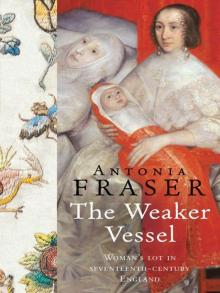 The Weaker Vessel: Women's Lot in Seventeenth-Century England
The Weaker Vessel: Women's Lot in Seventeenth-Century England Marie Antoinette: The Journey
Marie Antoinette: The Journey Oxford Blood
Oxford Blood Your Royal Hostage
Your Royal Hostage Cool Repentance
Cool Repentance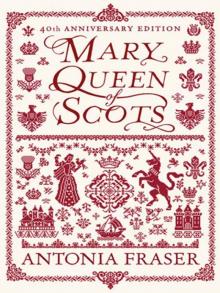 Mary Queen of Scots
Mary Queen of Scots Political Death
Political Death Royal Charles: Charles II and the Restoration
Royal Charles: Charles II and the Restoration My History: A Memoir of Growing Up
My History: A Memoir of Growing Up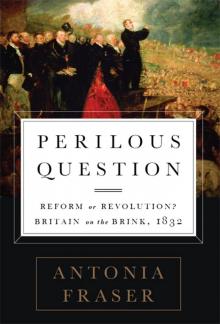 Perilous Question: Reform or Revolution? Britain on the Brink, 1832
Perilous Question: Reform or Revolution? Britain on the Brink, 1832 Jemima Shore at the Sunny Grave
Jemima Shore at the Sunny Grave A Splash of Red
A Splash of Red Must You Go?: My Life With Harold Pinter
Must You Go?: My Life With Harold Pinter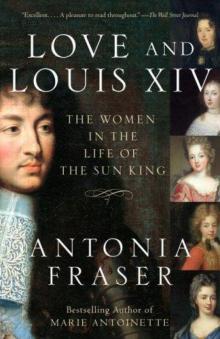 Love and Louis XIV: The Women in the Life of the Sun King
Love and Louis XIV: The Women in the Life of the Sun King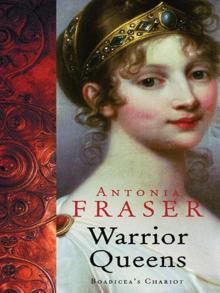 The Warrior Queens
The Warrior Queens The Wild Island
The Wild Island Quiet as a Nun
Quiet as a Nun Perilous Question
Perilous Question Cromwell, the Lord Protector
Cromwell, the Lord Protector Gunpowder Plots
Gunpowder Plots The Wild Island - Jemima Shore 02
The Wild Island - Jemima Shore 02 Gunpowder Plots: A Celebration of 400 Years of Bonfire Night
Gunpowder Plots: A Celebration of 400 Years of Bonfire Night Gunpowder Plots_A Celebration of 400 Years of Bonfire Night
Gunpowder Plots_A Celebration of 400 Years of Bonfire Night Marie Antoinette
Marie Antoinette Must You Go?
Must You Go? My History
My History